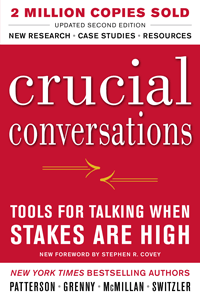I recently finished “Crucial Conversations. Tools for Talking When Stakes Are High” (Amazon) from Patterson et al, which describes how to productively hold emotionally challenging conversations. The book had been recommended to me by several colleagues.
What is the book about?

According to the book, crucial conversations are define as those conversations were:
there are high stakes
there are opposing opinions
there are strong emotions
The aim is, to hold these crucial conversations as a dialog. A dialog is a conversation where everyone can freely contribute to a growing pool of opinion. In non-dialog conversations people tend to make accusations or don’t contribute their views. In other words: they get violent or silent.
The book outlines a strategy to manage your own emotions in those conversations. Your emotions are created based on your interpretation (named story) of the facts you observe. It presents techniques to notice your interpretation explicitly and thereby handle your emotions better.
What was particularly interesting?
The most important learning for me was the part about being silent in a conversation. I have been silent in multiple crucial conversations in the past. In fact, I was confusing it with being diplomatic. But the authors of the book stress, that it is important to get all ideas freely on the table.
It was helpful to me to learn which techniques you can use - they are usually presented with an acronym. For instance the AMPP (ask, mirror, paraphrase and prime) technique to help others to overcome the silence, or the observe, tell a story, feel, act technique for understanding how emotions develop.
What is my conclusion?
I think the book has very interesting content. I'll definitely incorporate some of the ideas into my conversations. The book was presented in an easy to read way including many examples, which made the ideas presented very obvious.
I was expecting a bit more advice on conversations which don’t necessary involve so strong emotions - but maybe I should have rather picked a moderation book for that.
I didn’t like the introduction. It sounded a lot like an advertisement - and like the book would solve all problems humanity every had (which it doesn’t).
In summary, I think it is a good book to read for everyone who wants to learn about how humans communicate in emotional situations.